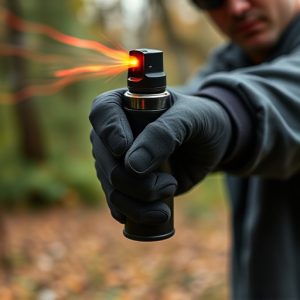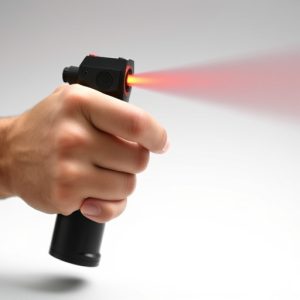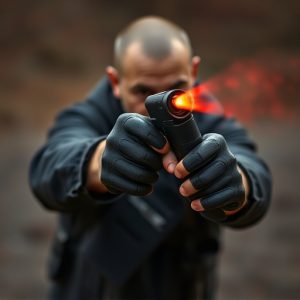Mastering Tactical Pepper Spray Deployment Techniques and Safety
Tactical pepper spray, a powerful non-lethal defense tool, offers diverse deployment methods for per…….
Tactical pepper spray, a powerful non-lethal defense tool, offers diverse deployment methods for personal protection, law enforcement, and security. Key components of dispensers include durable construction, quick-release triggers, ergonomic designs, and integrated lighting. Effective deployment techniques vary from direct face and eye blasts at close range to wider patterns for longer distances, ensuring safety and control in various scenarios. Understanding local laws and proper technique is crucial; always resort to pepper spray as a last measure against imminent threats. Regular training, storage, and functionality checks maximize its effectiveness while minimizing risk.
Tactical pepper spray is a powerful personal defense tool, offering immediate protection in dangerous situations. This article delves into the world of tactical grade pepper spray dispensers, exploring their key components and deployment techniques for maximum impact. We’ll guide you through understanding its role, benefits, and legal considerations, empowering you with effective tactical pepper spray deployment methods to enhance your safety and security.
- Understanding Tactical Pepper Spray: Its Role and Benefits
- Key Components of a Tactical Pepper Spray Dispenser
- Effective Deployment Techniques for Maximum Impact
- Legal Considerations and Safety Tips for Pepper Spray Use
Understanding Tactical Pepper Spray: Its Role and Benefits
Tactical pepper spray is a powerful tool designed for self-defense and law enforcement applications, offering a non-lethal yet effective means to incapacitate an attacker. Its primary role is to create a temporary but intense sensory overload, allowing users to gain time and space during potentially dangerous situations. The spray creates a burning sensation, reduced visibility, and respiratory distress in the target, providing a crucial window for escape or the intervention of authorities.
This versatile defense mechanism comes with various deployment methods tailored for different scenarios. From hand-held devices suitable for personal protection to specialized equipment used by tactical teams, there are numerous options available. Understanding these deployment methods is key to maximizing the benefits of tactical pepper spray, ensuring its effective use in self-defense, law enforcement operations, and security protocols.
Key Components of a Tactical Pepper Spray Dispenser
A tactical pepper spray dispenser is more than just a means of self-defense; it’s a tool designed for effective deployment in various high-risk scenarios. Key components include a robust and durable construction capable of withstanding extreme conditions, ensuring reliability when it matters most. The dispensing mechanism plays a vital role, employing advanced technologies like multi-mode activation to offer control over spray range, intensity, and direction.
Additionally, tactical pepper spray dispensers often incorporate features such as quick-release triggers, ergonomic designs for easy handling in stressful situations, and integrated lighting for low-light conditions. The choice of deployment methods also varies, from traditional hand-held models to more specialized options like ballistic mounts or holsters designed for tactical gear. These features collectively enhance the effectiveness and usability of the pepper spray during tactical operations.
Effective Deployment Techniques for Maximum Impact
When it comes to tactical pepper spray deployment methods, understanding effective techniques is paramount for maximizing impact and ensuring safety. The key lies in strategic application, taking into account factors like distance, angle, and environmental conditions. At close range (under 3 meters), a direct blast can be highly effective, aiming for the face and eyes to incapacitate quickly. For longer distances, a spray pattern that covers a wider area is ideal, allowing individuals or groups to be affected simultaneously.
Tactical pepper spray should be deployed in swift, controlled bursts, followed by quick retreat. This tactic minimizes exposure while maximizing the disruption caused by the irritant. Additionally, training and practice are invaluable; familiarizing oneself with various deployment methods ensures a measured response in high-pressure situations.
Legal Considerations and Safety Tips for Pepper Spray Use
When carrying a tactical pepper spray dispenser, it’s crucial to understand the legal considerations surrounding its use in your region. Different areas have varying laws and regulations regarding the possession and deployment of pepper spray for self-defense. Always check local statutes to ensure compliance; failure to do so could result in fines or legal repercussions.
Safety is paramount when employing tactical pepper spray deployment methods. Only use it as a last resort when facing an imminent threat. Be aware of wind direction, as the spray can blow back onto you. Practice proper application techniques and keep your target in mind—aim for the eyes and face to maximize effectiveness while minimizing exposure to yourself and bystanders. Store your spray safely, out of reach of children and unauthorized individuals, and regularly inspect it for functionality.
In conclusion, tactical pepper spray is a powerful tool that can provide significant advantages in self-defense scenarios. By understanding its role, key components, deployment techniques, and legal considerations, individuals can make informed decisions about carrying and using this effective defense mechanism. Mastering the various tactical pepper spray deployment methods ensures maximum impact while adhering to safety guidelines, making it an invaluable asset for personal protection.


